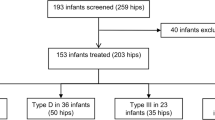Abstract
Purpose
Early detection and conservative treatment are essential for a successful outcome in developmental dysplasia of the hip (DDH). The aim of this study was to evaluate the efficacy of Tübingen hip flexion splint treatment on dislocated hips of type D, 3, and 4 according to the Graf classification.
Methods
A total of 104 dislocated hips in 92 patients were treated with Tübingen splints. Splint treatment was applied to patients with dislocated hips as diagnosed under ultrasonographic evaluation. After four to six weeks of treatment, the hips were re-evaluated according to the Graf classification under ultrasonography. The success of Tübingen splinting was determined as follows: hips initially diagnosed as Graf type 3 and 4 were upgraded to type 2c, 2b, or 1 after treatment, and hips initially diagnosed as Graf type D were upgraded to type 2b or 1 after treatment.
Results
The mean age at treatment initiation was 11.91 ± 5.16 (range, 4–32) weeks. There were no statistically significant relationships between success rates and sex, bilateral hip involvement, or initial physical examination findings (p > 0.05). The age at the start of treatment was found to be statistically significant in terms of the success of the splint (p = 0.03).
Conclusions
For successful treatment with Tübingen splints, the cut-off point of starting initial treatment was defined as the 15th week, with sensitivity of 84.62% and specificity of 62.50%. The success rate was 75% with a successful outcome in 78 hips. In view of these results, Graf type D, 3, and 4 dislocated hips can be successfully treated with Tübingen splints.



Similar content being viewed by others
References
Brdar R, Petronic I, Nikolic D, Lukac M, Cirovic D, Blagojevic T (2013) Walking quality after surgical treatment of developmental dysplasia of the hip in children. Acta Orthop Belg 79:60–63
Sewell MD, Eastwood DM (2011) Screening and treatment in developmental dysplasia of the hip – where do we go from here? Int Orthop 35:1359–1367
Atalar H, Gunay C, Komurcu M (2014) Functional treatment of developmental hip dysplasia with the Tübingen hip flexion splint. Hip Int 24:295–301
Seidl T, Lohmaier J, Hölker T, Funk J, Placzek R, Trouillier HH (2012) Reduction of unstable and dislocated hips applying the Tübingen hip flexion splint? Orthopade 41:195–199 (in German)
Tachdjian MO (1990) Pediatric orthopedics. WB Saunders, Philadelphia
Bernau A (1990) The Tübingen hip flexion splint in the treatment of hip dysplasia. Z Orthop Ihre Grenzgeb 128:432–435 (in German)
Pavone V, Testa G, Riccioli M, Evola FR, Avondo S, Sessa G (2015) Treatment of developmental dysplasia of hip with Tubingen hip flexion splint. J Pediatr Orthop 35:485–489
Uraş I, Yavuz OY, Uygun M, Yldrm H, Kömürcü M (2014) The efficacy of semirigid hip orthosis in the delayed treatment of developmental dysplasia of the hip. J Pediatr Orthop B 23:339–342
Graf R (2006) Hip sonography. Diagnosis and management of infant hip dysplasia, 2nd edn. Springer, Berlin
Tönnis D (1976) Normal values of the hip joint for the evaluation of X-rays in children and adults. Clin Orthop Relat Res 119:39-47
Bialik V, Bialik GM, Blazer S, Sujov P, Wiener F, Berant M (1999) Developmental dysplasia of the hip: a new approach to incidence. Pediatrics 103:93–99
Klisic PJ (1989) Congenital dislocation of the hip – a misleading term: brief report. J Bone Joint Surg (Br) 71:136
Suzuki S, Seto Y, Futami T, Kashiwagi N (2000) Preliminary traction and the use of under-thigh pillows to prevent avascular necrosis of the femoral head in Pavlik harness treatment of developmental dysplasia of the hip. J Orthop Sci 5:540–545
Weinstein SL, Mubarak SJ, Wenger DR (2004) Developmental hip dysplasia and dislocation: part II. Instr Course Lect 53:531–542
Ge Y, Wang Z, Xu Y (2018) Clinical study of anterior hip ultrasound (van Douveren's method)-assisted Pavlik harness. Int Orthop. https://doi.org/10.1007/s00264-018-4103-8
Hong K, Yuan Z, Li J, Li Y, Zhi X, Liu Y, Xu H, Canavese F (2018) Femoral anteversion does not predict redislocation in children with hip dysplasia treated by closed reduction. Int Orthop. https://doi.org/10.1007/s00264-018-4090-9
Cha SM, Shin HD, Shin BK (2018) Long-term results of closed reduction for developmental dislocation of the hip in children of walking age under eighteen months old. Int Orthop 42:175–182
Kitoh H, Kawasumi M, Ishiguro N (2009) Predictive factors for unsuccessful treatment of developmental dysplasia of the hip by the Pavlik harness. J Pediatr Orthop 29:552–557
Lerman JA, Emans JB, Millis MB, Share J, Zurakowski D, Kasser JR (2001) Early failure of Pavlik harness treatment for developmental hip dysplasia: clinical and ultrasound predictors. J Pediatr Orthop 21:348–353
Atalar H, Sayli U, Yavuz OY, Uraş I, Dogruel H (2007) Indicators of successful use of the Pavlik harness in infants with developmental dysplasia of the hip. Int Orthop 31:145–150
Suzuki S (1993) Ultrasound and the Pavlik harness in CDH. J Bone Joint Surg (Br) 75:483–487
Borowski A, Thawrani D, Grissom L, Littleton AG, Thacker MM (2009) Bilaterally dislocated hips treated with the Pavlik harness are not at a higher risk for failure. J Pediatr Orthop 29:661–665
Palocaren T, Rogers K, Haumont T, Grissom L, Thacker MM (2013) High failure rate of the Pavlik harness in dislocated hips: is it bilaterality? J Pediatr Orthop 33:530–535
White KK, Sucato DJ, Agrawal S, Browne R (2010) Ultrasonographic findings in hips with a positive Ortolani sign and their relationship to Pavlik harness failure. J Bone Joint Surg Am 92:113–120
Author information
Authors and Affiliations
Corresponding author
Ethics declarations
The institutional review board approved the chart review for this study (Number: 08.12.2014/536) and informed consent was obtained from all patients.
Conflict of interest
The authors declare that they have no conflict of interest.
Rights and permissions
About this article
Cite this article
Yegen, M., Atalar, H., Gunay, C. et al. Reduction of the dislocated hips with the Tübingen hip flexion splint in infants. International Orthopaedics (SICOT) 43, 2099–2103 (2019). https://doi.org/10.1007/s00264-018-4239-6
Received:
Accepted:
Published:
Issue Date:
DOI: https://doi.org/10.1007/s00264-018-4239-6




